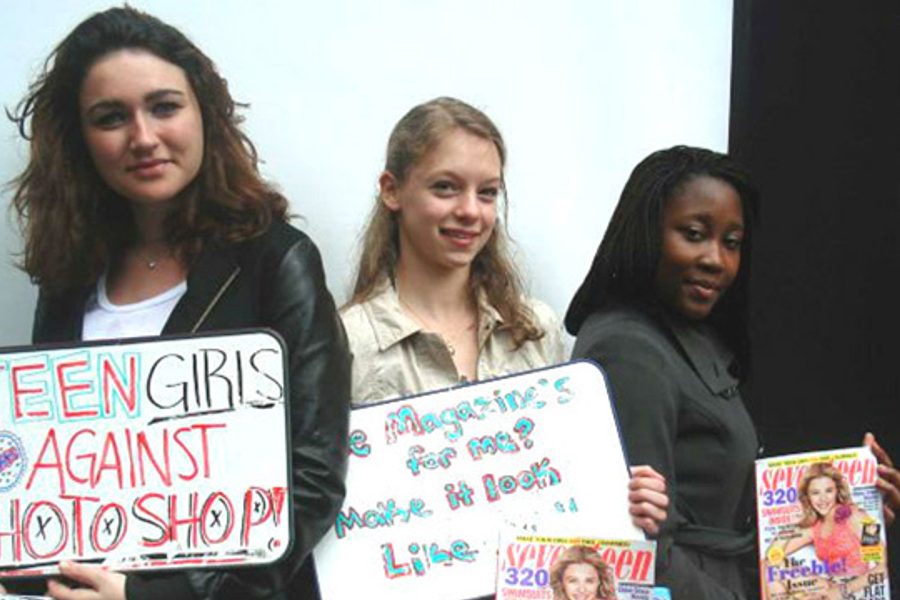84,000 Davids vs. Goliath
The media loves an individual underdog story, but successful activism always brings a crowd.
Jude Ellison Sady Doyle

As far as feminist cause celebres go, Julia Bluhm hits all the sweet spots. Her story looks, on the surface, like your classic David-and-Goliath situation: Bluhm is a 14-year-old girl from Waterville, Maine, who started an online petition to ban photo retouching in Seventeen magazine. That petition collected 84,000 signatures, resulted in a protest outside of Hearst headquarters and finally earned a promise from Editor Ann Shoket that the magazine would not retouch the body shapes of its models.
Massive media coverage, of course, has ensued. We love a story about the little guy (or, in this case, little girl) and will always read it, even if we haven’t read Seventeen in years, or decades. That’s the whole secret to any underdog narrative; everyone thinks of herself as a puny weakling, and will therefore rejoice in the downfall of pretty much anything she can define as “big.” The other secret, of course, is that — as in the case of Julia Bluhm — it is nearly always untrue.
In fact, Bluhm is not a little girl who just got mad about Seventeen and happened to start a massive protest. She’s a blogger for SPARK Summit, a youth activism organization run by adults. Which is to say: the story of the Seventeen protest is not the story of Julia Bluhm taking action, but the story of an established organization taking action through one of its representatives, Julia Bluhm. Here is how SPARK Summit describes itself, on its website:
SPARK is a girl-fueled activist movement to demand an end to the sexualization of women and girls in media.
And here is how Julia Bluhm describes herself, in her Change.org profile, from whence she launched the petition:
As a feminist, [Bluhm] not only wants to put a stop to sexualization and stereotypes of girls in the media, but also to negative stereotypes of ballet dancers.
Right below that, there’s a description of her connection to SPARK. This isn’t to rob Bluhm of credit; she did good work. But she didn’t do it alone, and to the extent that the Seventeen protest is being reported as Julia Bluhm’s protest, it’s being misreported.
And that misrepresentation is both sentimental and sloppy. Bluhm’s victory statement specifically directs credit, and supporters, back to other SPARK initiatives: “This is a huge victory, and I’m so unbelievably happy. Another petition is being started by SPARK activists Emma and Carina, targeting Teen Vogue.” And it signs off with a variation on the organization’s slogan: “We are sparking a change!”
If I sound crabby: Well, I am, a bit. But the media’s tendency to sentimentalize and simplify activism — and, particularly, its tendency to pick out lone heroes or heroines, normal people granted exceptional powers to fight evil — is an alarming one. A responsible account of social change should not, generally speaking, have the same plot as the first Spider-Man movie. And not only because this sort of thinking is trite, or lazy: Because it misrepresents the basic principles by which activism works.
The most famous case study for this is Rosa Parks and the Montgomery Bus Boycott, as the story is taught in schools. The story, typically, goes as follows: Rosa Parks was a nice lady. She worked hard all day, and her feet were tired. A white man asked her to give up her seat on the bus, and she said no. Then there was a boycott!
The rest of this story — that not only Parks, but three other black passengers, were asked to give up their seats, making Parks’ action collectively motivated from the first; that Parks was a long-standing member of the civil rights community, and had worked for the NAACP, and was therefore both well-versed in activism and well-connected with an activist community that could support her — tends to be omitted. And it tends to be omitted for two reasons: One, the “lady with tired feet” story is less threatening to racist and sexist sensibilities. Two, there seems to be an unconscious assumption that we will “like” Parks better if she’s “ordinary.” Sentimentality, the tale of the completely unexceptional person who just happens to do a good thing, prevails over rationality, the fact that people who learn how to do things tend to become good at doing them.
Similarly, a protest led by a little girl against a big magazine is a better human interest story than the fact that SPARK currently works with many young girls on similar actions, and has for years. But, again, the little-girl-big-Photoshop story just isn’t realistic. And it sends the wrong message to young activists, who deserve to know what sort of tools they’ll need. If Bluhm had no training, no connections, and no community, her protest simply wouldn’t have worked. To elide this fact will result in a lot of isolated and frustrated young petition-makers, wondering why they haven’t gotten 84,000 signatures yet.
To create social change requires intelligence, creativity, and a good sense of how to connect with potential supporters. But it also requires a pre-existing social network that is endowed with enough resources and pull to effectively spread the message. That’s less pleasing to the idealists among us than the tale of a lone girl overcoming vast obstacles. But it’s also a better blueprint for people who have obstacles they need to overcome. It’s great that Julia Bluhm was able to get a policy change from Seventeen. But her story can’t be told correctly unless it’s the story of at least 84,000 other names.
Jude Ellison Sady Doyle is an In These Times contributing writer. They are the author of Trainwreck: The Women We Love to Hate, Mock, and Fear… and Why (Melville House, 2016) and was the founder of the blog Tiger Beatdown. You can follow them on Twitter at @sadydoyle.








